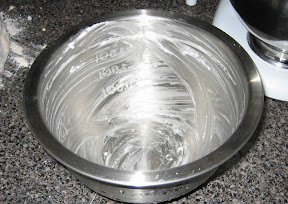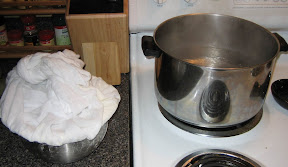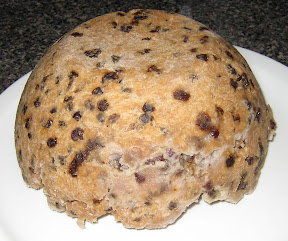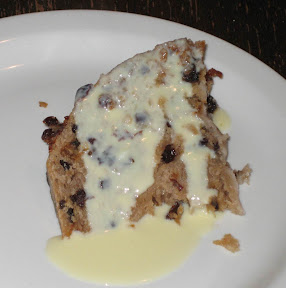Traditional English Pudding
Yesterday I decided to try something new, and made a
I recently bought a copy of "Lobscouse and Spotted Dog: Which it's a Gastrinomical Companion to the Aubrey-Maturin Series". It is a cookbook of all the foods mentioned in the book, written by devoted fans. I decided to try making a spotted dog, one of Jack's favorite puddings.
Puddings are part of the extensively described cuisine of the time, which I've always been curious about. English puddings are suet puddings, sometimes spiced, or flavored with dried currants or rasins (known then as figs and plums, go figure). They are usually boiled in a cloth or steamed in a bowl for a few hours. Names from the Aubrey-Maturin series include "Plum duff", "Figgy-dowdy", "Spotted Dog", and "Drowned Baby".
A spotted dog is a pudding steamed in a basin. This recipe used actual flour, instead of pounded ship's bisquit (which would have been the norm a few months out of port). Instead of grated suet, I used shortening (Katy is a vegetarian).
First, you need a greased pudding basin:

This is a 2 pint steel bowl with a significant lip, for tying the pudding cloth.
Next, the batter:

The batter is made from flour, shortening, eggs, and a little sugar. It is flavored with nutmeg, cinnamon and about two cups of dried currants.
The pudding is placed in the greased basin and a pudding cloth is tied on top. It's a peice of flour sacking which has been floured and wetted. The pudding is then steamed in a pot for about two hours.

When it is turned out of the basin, it's ready to be served!

On or near land, the pudding would be served with a sauce. I chose Custard Sauce (also know as creme Anglaise), again using the traditional recipes.

The pudding itself was delicious. It was heavy and sweet and spicy. Katy loved it as well, and I'm definitely doing it again!

I recently bought a copy of "Lobscouse and Spotted Dog: Which it's a Gastrinomical Companion to the Aubrey-Maturin Series". It is a cookbook of all the foods mentioned in the book, written by devoted fans. I decided to try making a spotted dog, one of Jack's favorite puddings.
Puddings are part of the extensively described cuisine of the time, which I've always been curious about. English puddings are suet puddings, sometimes spiced, or flavored with dried currants or rasins (known then as figs and plums, go figure). They are usually boiled in a cloth or steamed in a bowl for a few hours. Names from the Aubrey-Maturin series include "Plum duff", "Figgy-dowdy", "Spotted Dog", and "Drowned Baby".
A spotted dog is a pudding steamed in a basin. This recipe used actual flour, instead of pounded ship's bisquit (which would have been the norm a few months out of port). Instead of grated suet, I used shortening (Katy is a vegetarian).
First, you need a greased pudding basin:

This is a 2 pint steel bowl with a significant lip, for tying the pudding cloth.
Next, the batter:

The batter is made from flour, shortening, eggs, and a little sugar. It is flavored with nutmeg, cinnamon and about two cups of dried currants.
The pudding is placed in the greased basin and a pudding cloth is tied on top. It's a peice of flour sacking which has been floured and wetted. The pudding is then steamed in a pot for about two hours.

When it is turned out of the basin, it's ready to be served!

On or near land, the pudding would be served with a sauce. I chose Custard Sauce (also know as creme Anglaise), again using the traditional recipes.

The pudding itself was delicious. It was heavy and sweet and spicy. Katy loved it as well, and I'm definitely doing it again!
